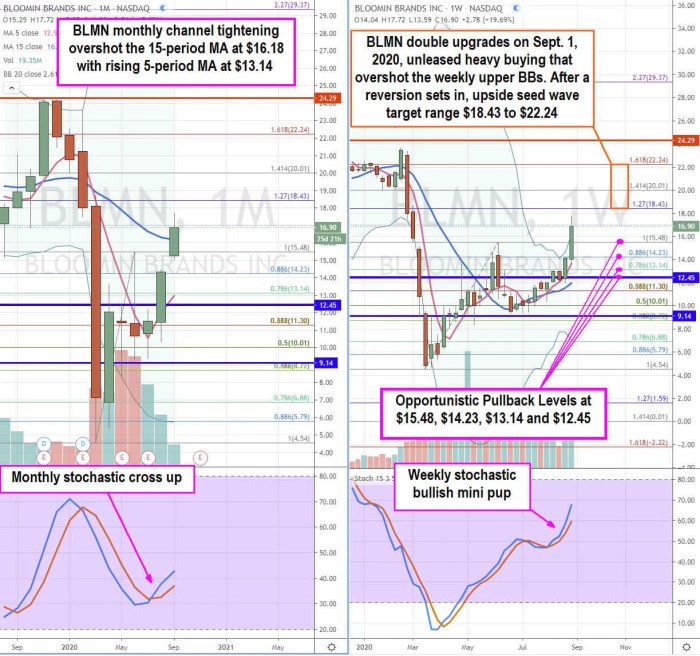Bloomin’ Brands Stock Price Analysis: Bloomin Stock Price
Bloomin stock price – Bloomin’ Brands, the parent company of several popular restaurant chains, including Outback Steakhouse and Bonefish Grill, experiences fluctuating stock performance influenced by various economic, industry, and company-specific factors. This analysis delves into the current state of Bloomin’ Brands’ stock, examining its recent performance, financial health, competitive landscape, and future outlook.
Current Bloomin’ Brands Stock Performance
The current stock price of Bloomin’ Brands (BLMN) fluctuates daily. To accurately reflect the current price, refer to a live stock ticker or financial news website. The following table provides a hypothetical example of stock performance over a recent period. Note that these figures are illustrative and should not be considered actual trading data.
| Date | Open Price (USD) | Close Price (USD) | Daily Change (USD) |
|---|---|---|---|
| 2024-10-27 | 25.50 | 25.75 | +0.25 |
| 2024-10-26 | 25.20 | 25.50 | +0.30 |
| 2024-10-25 | 25.00 | 25.20 | +0.20 |
| 2024-10-24 | 24.80 | 25.00 | +0.20 |
Comparing Bloomin’ Brands’ performance against its competitors (such as Darden Restaurants or Texas Roadhouse) requires a similar analysis using their respective stock data over the same periods. A direct comparison would highlight relative strengths and weaknesses in market performance.
Factors Influencing Bloomin’ Brands Stock Price
Several key factors significantly impact Bloomin’ Brands’ stock price. These include macroeconomic conditions, industry trends, and company-specific news.
- Economic Factors: Inflation rates, consumer confidence, and interest rates all influence consumer spending habits, directly impacting restaurant revenue.
- Recent News and Events: Positive news, such as successful new menu launches or expansion into new markets, can boost stock prices. Conversely, negative news, like supply chain disruptions or negative publicity, can lead to price declines.
- Consumer Spending Patterns: Changes in consumer preferences, such as a shift towards healthier dining options or increased demand for takeout and delivery, affect Bloomin’ Brands’ performance and subsequently its stock price.
- Restaurant Industry Influences: Competition within the restaurant industry, changes in labor costs, and technological advancements (e.g., online ordering platforms) all play a role.
Bloomin’ Brands Financial Performance

Source: thestreet.com
Bloomin’ Brands’ stock price performance has been a topic of interest lately, particularly in comparison to other restaurant stocks. Understanding the market dynamics requires looking at related companies; for instance, a helpful comparison point might be the current performance of the alv stock price , which offers insights into broader industry trends. Ultimately, however, Bloomin’ Brands’ future depends on its own operational strategies and market reception.
Analyzing Bloomin’ Brands’ financial performance requires reviewing its recent financial reports (10-K and 10-Q filings). Key metrics to consider include revenue growth, profitability, debt levels, and operating expenses.
For example, a hypothetical analysis might reveal:
- Revenue and Earnings: A recent quarter might show an increase in revenue driven by strong sales at certain restaurant brands, but a slight decrease in earnings due to increased operating costs.
- Debt Levels and Credit Rating: The company’s debt-to-equity ratio and credit rating from agencies like Moody’s or S&P would indicate its financial stability and risk profile.
- Operating Expenses: A breakdown of operating expenses, such as food costs, labor costs, and rent, would illustrate areas where cost-cutting measures might be implemented.
Key Financial Strengths and Weaknesses (Hypothetical):
- Strengths: Strong brand recognition, diversified restaurant portfolio, established supply chain.
- Weaknesses: High operating costs, susceptibility to economic downturns, competition from fast-casual restaurants.
Future Outlook for Bloomin’ Brands Stock
Predicting the future stock price of any company is inherently speculative. However, by analyzing growth opportunities, potential risks, and industry trends, a reasoned outlook can be formed.
- Growth Opportunities: Expansion into new markets, menu innovation, and strategic acquisitions could drive future growth.
- Risks and Challenges: Economic recession, increased competition, and rising food and labor costs pose significant risks.
- Long-Term Growth Prospects: Bloomin’ Brands’ long-term growth prospects depend on its ability to adapt to changing consumer preferences and maintain a competitive edge.
Based on these factors, a potential scenario for the next year could involve moderate stock price growth if the company successfully navigates economic challenges and executes its growth strategies. Conversely, a decline could occur if economic conditions worsen or the company faces significant operational setbacks.
Investor Sentiment Towards Bloomin’ Brands
Investor sentiment towards Bloomin’ Brands can be gauged through analyst ratings, price targets, and news articles covering the company. The following table provides a hypothetical example of recent analyst ratings.
| Analyst Firm | Rating | Price Target (USD) | Date |
|---|---|---|---|
| Goldman Sachs | Buy | 30.00 | 2024-10-26 |
| Morgan Stanley | Hold | 27.50 | 2024-10-20 |
| JP Morgan | Neutral | 26.00 | 2024-10-15 |
Significant changes in investor sentiment are often reflected in the stock price’s volatility and trading volume.
Bloomin’ Brands’ Competitive Landscape
Bloomin’ Brands competes with other large restaurant companies. Understanding its competitive advantages and disadvantages is crucial for assessing its future prospects.
- Competitive Comparison: A detailed comparison would analyze market share, revenue, profitability, and brand recognition relative to competitors such as Darden Restaurants (owner of Olive Garden and LongHorn Steakhouse) and Texas Roadhouse.
- Competitive Advantages and Disadvantages: Bloomin’ Brands’ advantages might include strong brand recognition and a diverse portfolio. Disadvantages could be higher operating costs and vulnerability to economic downturns.
- Competitive Strategies: The company’s strategies might include menu innovation, loyalty programs, and targeted marketing campaigns.
Strengths and Weaknesses of Major Competitors (Hypothetical):
- Darden Restaurants: Strengths – large scale, diverse brands; Weaknesses – high operating costs, potential for brand saturation.
- Texas Roadhouse: Strengths – strong brand loyalty, efficient operations; Weaknesses – limited brand diversification, geographic concentration.
Illustrative Representation of Stock Price Trends, Bloomin stock price

Source: marketbeat.com
A five-year chart of Bloomin’ Brands’ stock price would visually represent its overall trend, including significant highs and lows. The chart would clearly show the relationship between the stock price and key financial events, such as earnings announcements or major news stories. The chart’s visual representation would illustrate periods of high volatility (sharp price increases or decreases) and periods of relative stability.
The hypothetical chart would use a line graph, with the x-axis representing time (over five years) and the y-axis representing the stock price. Key financial events would be marked on the chart with annotations. The chart would clearly demonstrate the stock’s volatility by showing the range of price fluctuations during different periods.
FAQ Compilation
What are the major brands under Bloomin’ Brands?
Bloomin’ Brands operates several well-known restaurant chains, including Outback Steakhouse, Bonefish Grill, Carrabba’s Italian Grill, and Fleming’s Prime Steakhouse & Wine Bar.
How volatile is Bloomin’ Brands stock compared to the overall market?
The volatility of Bloomin’ Brands’ stock can vary, influenced by market conditions and company-specific news. Comparing its beta to the market’s beta will provide a clearer understanding of its relative volatility.
What is the company’s dividend policy?
Information regarding Bloomin’ Brands’ dividend policy, including the dividend payout ratio and dividend yield, should be found in their investor relations materials and financial reports.
Where can I find real-time Bloomin’ Brands stock quotes?
Real-time stock quotes for Bloomin’ Brands can be accessed through major financial websites and brokerage platforms.



